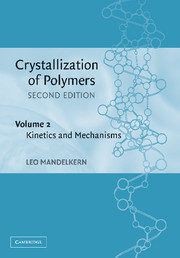11 - Crystallization kinetics of polymer mixtures
Published online by Cambridge University Press: 15 December 2009
Summary
Introduction
A large number of studies concerned with the crystallization kinetics of polymer–polymer mixtures have been reported. One reason for this abundance of information is a basic scientific interest coupled with the many ramifications that are inherent to such systems. There is also a pragmatic interest since physical and mechanical properties, as well as environmental features, can be altered and controlled by the appropriate mixing of polymeric components. It is useful to follow the same methodology used in discussing the equilibrium aspects of crystalline polymer–polymer mixtures (see Chapter 4, Volume 1) when analyzing their crystallization kinetics.
The nature of the melt and the pathway followed during the course of the transformation are important factors in governing the crystallization kinetics of binary mixtures. Depending on the molecular weight, the structural regularity of the chain and the value of the interaction parameter χ1, the blends can be either completely miscible over the complete composition range, partially miscible or completely immiscible. Phase separation may occur upon increasing or decreasing the temperature, depending on the change in χ1. Thus a lower or upper critical solution temperature, or both, can be observed. In order for a proper analysis to be made of the crystallization kinetics in blends, it is important that the complete phase diagram be established for partially miscible systems.
- Type
- Chapter
- Information
- Crystallization of Polymers , pp. 282 - 347Publisher: Cambridge University PressPrint publication year: 2004
- 1
- Cited by



